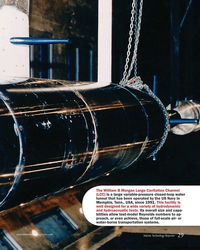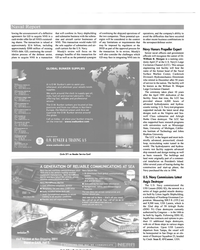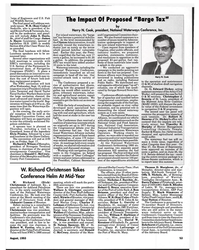Large Cavitation Channel
-
- N a v y Honors Propeller Expert Maritime Reporter, May 2001 #28
Senior naval officers and government officials will recognize the career of Dr.
William B. Morgan in a naming ceremony April 27 at the U.S. Navy's Large Cavitation Channel (LCC). This unique engineering test facility will bear the name of the former head of the Naval Surface Warfare Center, Carderock Division's Hydromechanics Directorate who retired in December after 50 years of service to the nation. The facility will be known as the William B. Morgan Large Cavitation Channel.
The ceremony takes place 10 years after the April 1991 dedication of the facility. Since that time, the LCC has provided almost 6,000 hours of advanced hydrodynamic and hydroacoustic testing. U.S. Navy test programs supported include the latest naval ship designs such as the Virginia and Seawolf Class submarine and Arleigh Burke Class destroyer. The LCC has also supported basic research programs with universities such as Mississippi State, University of Michigan, California Institute of Technology and Johns Hopkins University.
The LCC is the largest and most technically advanced, pressurized, closedloop, recirculating water tunnel in the world. The hydrodynamic and hydroacoustic test facility supports advanced ship research and design testing as well as basic research. The buildings and land were originally part of a commercial installation on President's Island.
After several years of leasing during the construction and start-up phase, the Navy purchased the site in 1994.
-
- Propeller Milestone Achieved By U.S. Navy Maritime Reporter, Feb 2000 #10
Company, the hub designer and prop fabricator, designed the blades. Small scale prop models were then tested in another unique Carderock facility, the Large Cavitation Channel, in Memphis, Tenn. There, scaled props are mounted on ship model hulls where the flow of water over the hull and around the
-
- Navy Tests Scale Models in Big Facilities Marine Technology, May 2018 #28
Virginia-class boat, for the evaluation of design changes and new technologies to ensure the boats are as quiet as possible.The William B. Morgan Large Cavitation Channel (LCC) is located on the banks of the Mississippi River in Memphis, Tenn. The LCC is like a wind tunnel, but filled with a 1.5 million gallons
-
- New MASK Unveiled Marine Technology, Mar 2014 #72
, Carderock engineers and scientists will use the new MASK facility along with the 3,000 foot high speed and deep water towing basins and the Large Cavitation Channel in Memphis to study advanced hull forms and ship designs for seakeeping studies and survivability at sea. “There’s a small degree of overlap
-
 )
May 2018 - Marine Technology Reporter page: 29
)
May 2018 - Marine Technology Reporter page: 29The William B Morgan Large Cavitation Channel (LCC) is a large variable-pressure closed-loop water tunnel that has been operated by the US Navy in Memphis, Tenn., USA, since 1991. This facility is well designed for a wide variety of hydrodynamic and hydroacoustic tests. Its overall size and capa- bilitie
-
 )
May 2001 - Maritime Reporter and Engineering News page: 28
)
May 2001 - Maritime Reporter and Engineering News page: 28Directorate who retired in December after 50 years of service to the nation. The facility will be known as the William B. Morgan Large Cavitation Channel. The ceremony takes place 10 years after the April 1991 dedication of the facility. Since that time, the LCC has provided almost 6
-
 )
March 2014 - Marine Technology Reporter page: 74
)
March 2014 - Marine Technology Reporter page: 74de- partment, Carderock engineers and sci-entists will use the new MASK facility along with the 3,000 foot high speed and deep water towing basins and the Large Cavitation Channel in Memphis to study advanced hull forms and ship designs for seakeeping studies and survivability at sea. ?There?s a small
-
 )
August 1993 - Maritime Reporter and Engineering News page: 51
)
August 1993 - Maritime Reporter and Engineering News page: 51Wednesday, Sept. 15, with an inspection trip to President's Island, Litco Terminal and David Taylor Naval Surface Warfare Basin to see the large cavitation channel, the most advanced and largest cavita- tion water tunnel in the world. Reg- istration will begin at 2:00 p.m., the same time that the
